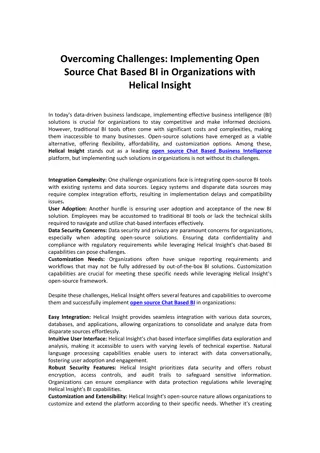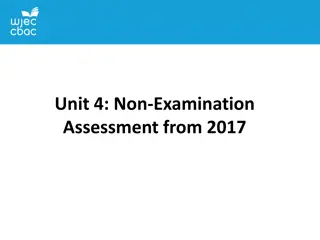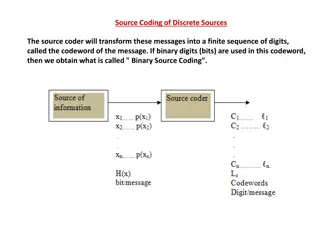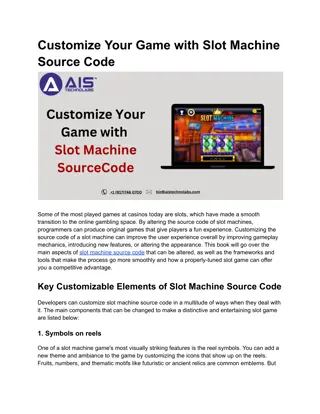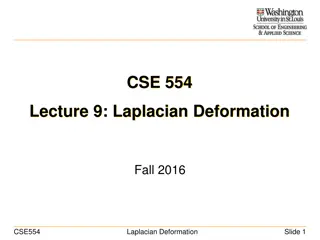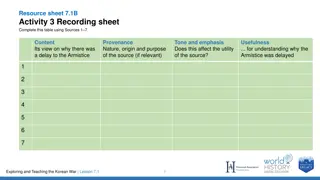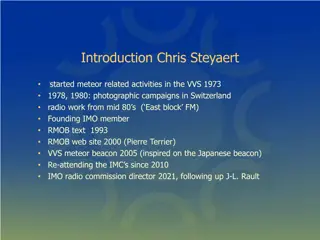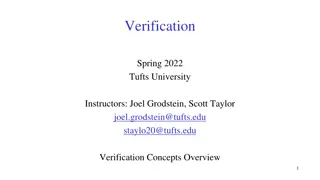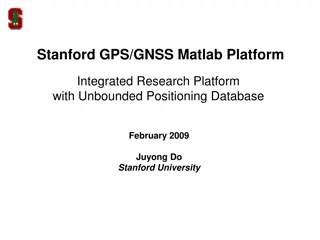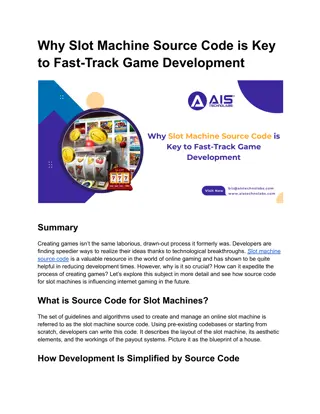Netdata - The Open Source Observability Platform: A Comprehensive Overview
Netdata is an open-source observability platform created by Costa Tsaousis. It enables real-time, high-resolution monitoring with auto-discovery of integrations, unsupervised machine learning for metrics, alerting, visualization, and anomaly detection. With easy installation on any system, Netdata provides detailed insights into various performance metrics and system health, making it a valuable tool for monitoring infrastructure in both cloud and on-premises environments.
Download Presentation

Please find below an Image/Link to download the presentation.
The content on the website is provided AS IS for your information and personal use only. It may not be sold, licensed, or shared on other websites without obtaining consent from the author.If you encounter any issues during the download, it is possible that the publisher has removed the file from their server.
You are allowed to download the files provided on this website for personal or commercial use, subject to the condition that they are used lawfully. All files are the property of their respective owners.
The content on the website is provided AS IS for your information and personal use only. It may not be sold, licensed, or shared on other websites without obtaining consent from the author.
E N D
Presentation Transcript
Netdata the open-source observability platform everyone needs Costa Tsaousis
2 Page: About Netdata Born out of a need While migrating a large infra from on-prem to cloud, we were facing unexplainable issues - existing monitoring solutions (open-source and commercial) failed to diagnose, or even surface. Born out of curiosity Experimented to understand if and how a monitoring solution could be real-time, high-resolution, easier, simpler and out of the box. Born on GitHub, open-source from the very beginning The love and adoption by the community gave substance and a future to Netdata. GitHub URL:
3 Page: The Netdata way Auto-discover 800+ integrations and k8s autodiscovery supported. Collect Pull and Push model, using the optimal protocol for each application. Netdata is a monitoring in a box Store Embedded high performance time-series database. Learn Unsupervised Machine Learning for every metric. Check Predefined & custom alerts and notifications. Query & Score API for querying, analyzing, scoring and correlating time-series data. Visualize Fully automated dashboards. Stream & Replicate Build metrics centralization points.
4 Page: Netdata on an empty VM 200+ dashboard chars, 2000+ unique time-series CPU, Memory, Disks, Mount Points, Filesystems, Network Interfaces, the whole Networking Stack for all Protocols, Firewall, systemd Units, Processes, Users, User Groups and more. All collected and visualized with 1-second granularity. 50+ unique alerts, on 100+ components Checking the health of every single component the system has, for common errors, misconfigurations, and error conditions. What you get by just installing Netdata on an empty VM systemd-journal logs explorer Visualize the explore system and application logs, by directly querying systemd journals, without the need of logs database server. Network explorer Visually explore all network sockets (to be release this month). Unsupervised anomaly detection 18 Machine Learning models are trained for each time-series collected, modeling the behavior of each metric over the last few days, offering outlier detection in real-time, during data collection. 2 months of retention using 500MB of disk space 3 days of high-res (per-sec), 2 weeks of mid-res (per-min), 2 months of low-res (per-hour). 1% CPU of a single core, 120MB RAM, almost zero disk I/O Optimized for speed and efficiency, a nice companion for production systems and applications.
5 Page: The Netdata way - standalone Install the agent on all your systems. Dashboards Metrics & Logs Alerting Servers S1 S2 S3 S4 S5
6 Page: The Netdata way - distributed fully on-prem Install the agent on all your systems, Use a Netdata Parent for a unified view. Netdata Parent Dashboards Metrics & Logs Alerting S6 Netdata Parent is the same open-source software to all other Netdata. Servers S1 S2 S3 S4 S5 Cloud Provider 1
7 Page: The Netdata way - multi-level Netdata Grandparent Dashboards Metrics & Logs GP Alerting PA PC Netdata Parent Netdata Parent PB Netdata Parent A1 A2 A3 A4 A5 C1 C2 C3 C4 C5 Data Center 1 Data Center 2 B1 B2 B3 B4 B5 Cloud Provider 1
8 Page: Netdata vs Prometheus -35% CPU Utilization Netdata: 1.8 CPU cores per million of metrics/s Prometheus: 2.9 CPU cores per million of metrics/s Stress tested Netdata parent and Prometheus with 500 servers, 40k containers, at 2.7 million metrics/s -49% Peak Memory Consumption Netdata: 49 GIB Prometheus: 89 GiB -12% Bandwidth Netdata: 227 Mbps Prometheus: 257 Mbps -98% Disk I/O Netdata: 3 MiB/s (no reads, 3 MiB/s writes) Prometheus: 129 MiB/s (73.6 MiB/s reads, 55.2 MiB/s writes) -75% Storage Footprint Netdata: 10 days per-sec, 43 days per-min, 467 days per-hour Prometheus: 7 days per-sec :full comparison URL
9 Page: Netdata is the most energy efficient platform! In December 2023, University of Amsterdam published a study related to the impact of monitoring tools for Docker based systems, aiming to answer 2 questions: Netdata outperforms all other monitoring solutions in energy efficiency! 1. What is the impact of monitoring tools on the energy efficiency of Docker-based systems? 2. What is the impact of monitoring tools on the performance of Docker-based systems? They tested ELK, Prometheus, Netdata and Zipkin, under 9 different configurations. This is how Netdata stands: Netdata excels in energy efficiency: "... Netdata being the most energy-efficient tool ...", as the study says. Netdata excels in CPU Usage, RAM Usage and Execution Time. - :full comparison URL -
10 Page: Netdata in CFNF Netdata Netdata is leading the observability category in the CNCF landscape, in terms of users love. 66.9k stars The open-source observability platform everyone needs! Elasticsearch 66.6k stars Free and Open, Distributed, RESTful Search Engine. Grafana 59.1k stars The open and composable observability and data visualization platform. Visualize metrics, logs, and traces from multiple sources like Prometheus, Loki, Elasticsearch, InfluxDB, Postgres and many more. Prometheus 51.6k stars The Prometheus monitoring system and time series database. Jaeger Disclaimer: Netdata is a member of, and supports CNCF, but the project is not endorsed nor incubating in CNCF (because we don t want to). This list indicates only users love, expressed as Github stars. 19.0k stars CNCF Jaeger, a Distributed Tracing Platform.
Netdata Challenge 1: from zero to hero, today!
12 Page: We have a lot in common Similar physical or virtual hardware We all use a finite set of physical and virtual hardware. This hardware may be different in terms of performance and capacity, but the technologies involved are standardized. Since we have so much in common, why it takes so long to set up a monitoring solution? Similar operating systems We all use flavors of a small set of operating systems, exposing a finite set of metrics covering the monitoring of all system components and operating system layers. Packaged applications Most of our infrastructure is based on packaged applications, like web servers, database servers, message brokers, caching servers, etc. Standard libraries Even for our custom applications, we usually rely on packaged libraries that expose telemetry in a finite and predictable way.
13 Page: NIDL, the model for rapid deployment Nodes The node the data are coming from. NIDL stands for: - Nodes - Instances - Dimensions - Labels Contexts The kind of metrics, like disk.io , cgroup.cpu , nginx.requests . Equivalent with the metric name in Prometheus. Instances The unique instances of the things being monitored. For example /dev/sda and /dev/sdb are two instances (disks) for which we monitor disk.io (context). Equivalent of a combination of some of the labels of a metric in Prometheus. Dimensions The attributes of the instances monitored. For example read and write are Dimensions of the disk.io context, of the /dev/sda instance (disk). Dimensions get values and maintain a time-series. Equivalent of a unique time-series in Prometheus. The name comes from the slicing and dicing controls on all Netdata charts.
Page:14 NIDL: how it looks? Every chart on the dashboard is a context, aggregating all the instances from all nodes selected, for the visible timeframe. Dashboard configuration is done per context. Example: apply units to all dimensions, set default dicing settings, provide additional information to help users understand what they see, and more. Context (disk.io) Alerts are configured for contexts, but they are applied to instances. Example: apply this disk.io alert to all disks or even apply this disk.io alert to all NVME disks . Instances have labels, and alert variables related to the component they refer to (for example, disks have a model, a serial number, a kind, etc). Instance (/dev/sda) Instance (/dev/sdb) Instance (/dev/sdc) Variables lookup is smart to match the component the alert is linked to. Dimensions have values, time-series data. read write read write read write
Page:15 NIDL: how it looks? Component 1 /dev/sda Component 2 /dev/sdb Instance (of disk.io) MiB/s Instance (of disk.ops) IOPs Instance (of disk.busy) ms Instance (of disk.io) MiB/s Instance (of disk.ops) IOPs Instance (of disk.busy) ms Common Label Values Common Label Values read write read write busy read write read write busy Common Units, Dimension names, Variable names Common Label names
16 Page: NIDL: the result Netdata incorporates all the knowledge and skills required to set up a monitoring system Fully automated visualization Netdata visualizes all metrics in a meaningful way, by correlating the right dimensions together and applying the right settings for each case. Fully automated alerts Netdata comes with preconfigured alerts for 350 unique components and applications. All these alert templates are applied automatically to the right components, applications and charts. Slice and dice easily from the UI The NIDL framework enables easy slicing and dicing of the data from the UI, without the need to learn a query language.
17 Page: Mission accomplished! Just install it One moving part: Netdata. Batteries included! (i.e. data collection plugins and all needed modules are shipped with Netdata). Auto-discovers all metrics Data collection does not require configuration, unless the monitored data are password protected (Netdata needs the password). Data collection plugins provide metrics with the NIDL framework embedded into them. Designed to be installed mid- crisis! Fully automated visualization Dashboards are available 1 second after Netdata starts. Pre-configured alerts If something is wrong, an alert will fire-up just a few seconds after installation. High Fidelity High granularity: per second data collection and visualization as a standard. High cardinality: the more metrics the better the troubleshooting gets.
Netdata Challenge 2: get rid of the query language for slicing and dicing data
19 Page: Slice and dice from the UI Netdata collects a vast number of metrics you will probably see for the first time Since users haven t configured the metrics themselves, can we provide a UI that can explain what users see? How users will be able to slice and dice the data on any chart, the way it makes sense for them?
Page:20 A Netdata Chart :Netdata Parent URL Netdata Cloud Live Demo URL:
Page:21 Info Button: Help about this chart Info button includes links to relevant documentation and/or some helpful message about the metrics on each chart.
Page:22 A Netdata Chart - controls NIDL Controls - review data sources and slice/filter them (NIDL = Nodes, Instances, Dimensions, Labels) Aggregation across time Aggregation across metrics Dice the data Anomaly rate ribbon Info ribbon
Page:23 A Netdata Chart - anomaly rate per node Similar analysis is available per Instance ( application in this chart), dimensions, and labels. Clicked on Nodes Instances per Node contributing to this chart The visible volume each Node is contributing to this chart The minimum, average and maximum values across all metrics this Node contributes Filter Nodes Unique time-series per Node contributing to this chart The anomaly rate each Node contributes to this chart contributing data to this chart
Page:24 Dicing any chart, without queries Result: dimension,device_type
Page:25 Info Ribbon: Missing data collections A missed data collection is a gap, because something is wrong! Netdata does not smooth out the data.
26 Page: Mission accomplished! The Netdata query engine, does all the calculations, for all drop down menus and ribbons in one go and returns everything in a single query response. All this additional information is available on every query, every chart, every metric! All queries, include all information needed: - - - - - Per Node Per Instance (disk, container, database, etc) Per Dimension Per Label Key Per Label Value Providing: - - - - - Availability of the samples (gaps), over time Min, Average and Maximum values Anomaly Rate for the visible timeframe Volume contributing to the chart Number of Nodes, Instances, Dimensions, Label Keys, Label Values matched
Netdata Challenge 3: make machine learning and anomaly detection useful for observability
28 Page: AI for observability is tricky Google: Wednesday, 2 October, 2019 All of Our ML Ideas Are Bad Todd Underwood, Google The vast majority of proposed production engineering uses of Machine Learning (ML) will never work. They are structurally unsuited to their intended purposes. There are many key problem domains where SREs want to apply ML but most of them do not have the right characteristics to be feasible in the way that we hope. After addressing the most common proposed uses of ML for production engineering and explaining why they won't work, several options will be considered, including approaches to evaluating proposed applications of ML for feasibility. ML cannot solve most of the problems most people want it to, but it can solve some problems. Probably. (and We Should Feel Bad) :URL
29 Page: What does Netdata do with Machine Learning? Trains a ML model per metric, every 3 hours, using the last 6 hours of data of each metric. Default ML Configuration In Netdata Maintains 18 ML models per metric, covering the last few days. Detects anomalies in real-time, while data are being collected every second. All available ML models for a metric need to agree that a collected sample is an outlier, for Netdata to consider it an Anomaly. Stores Anomaly Rate together with collected data. Calculates Host-level Anomaly Score.
30 Page: Netdata s scoring engine A scoring engine, a unique feature across all monitoring systems. Netdata can score all metrics based on their anomaly rate for any given time-frame! All metrics, independently of their context, can be scored across time, based on various parameters, including their anomaly rate. Metrics correlations is a subset of the scoring engine, that can score metrics based on their rate of change (data), anomaly rate of change (anomaly rate), but also based on volume, similarity, and more.
Page:31 A Netdata dashboard One fully automated dashboard, with infinite scrolling, presenting and grouping all metrics available. Quick access to all sections using the index on the right. Multi-dimensional data on every chart, using chart controls to slice and dice any dataset. AI assisting on every step.
Page:32 A Netdata Dashboard - what is anomalous? Anomaly Rate button Time-frame picker Anomaly rate per section for the time-frame
33 Page: Anomaly Advisor Anomaly advisor assists in finding the needle in the haystack. Uses Host Anomaly Rate to identify durations of interest. Host Anomaly Rate is the percentage of the metrics of a host, that were found to be anomalous concurrently. So, 10% host anomaly rate, means that 10% of all the metrics the host exposes, were anomalous at the same time, showing the spread of an anomaly.
Page:34 Anomaly Advisor - starting point Percentage of Host Anomaly Rate Number of metrics concurrently anomalous
Page:35 Anomaly Advisor - triggering the analysis Highlighting an area on the chart, triggers the analysis
Page:36 Anomaly Advisor - the analysis Anomaly advisor presents a sorted list of all metrics, ordered by their anomaly rate, during the highlighted time- frame.
37 Page: Mission accomplished! Netdata turns AI to a consultant that can help you spot what is interesting, what is related, what needs your attention. Unsupervised Anomaly Detection is an advisor! Unsupervised There are plenty of settings, but it just works behind the scenes, learning how metrics behave and providing an anomaly score for them. It is just another attribute for each of your metrics Anomaly Rate is stored in the metrics database together with every sample collected, making it possible to query the past for anomalies. Can detect the spread of an anomaly across systems and applications. Can assist finding the aha! moment while troubleshooting.
Netdata Challenge 4: Make logs exploration and analytics, easy and affordable.
39 Page: Systemd-journald Is available everywhere! We use it already, even when we don t realize it. Is secure by design! FSS, to seal the logs Survives disk failures (uses tmpfs) Its file format is designed for minimal data loss on disk corruption Is unique! Supports any number of fields, even per log entry (think huge cardinality) Indexes all fields provided Queries on any combination of fields Maintenance free - just works! Amazing ingestion performance! systemd-journald is a hidden gem, that already lives in our systems! Can build logs centralization points It provides all the tools and processes to centralize all the logs of an infra to a central place.
Page:40 Netdata systemd-journal Logs Explorer
41 Page: Systemd-journald: it is slow to query Yes and No. The query performance issues are simple implementation glitches, easy to fix. systemd-journal is not slow when used with Netdata We submitted patches to systemd We analyzed journalctl and found several issues that once fixed they improve query performance 14x. We submitted these patches to systemd. Netdata systemd-journal Explorer We managed to bypass all the performance issues systemd- journal has, independently of the version of systemd installed on a system. Netdata is fast when querying systemd-journal logs on all systems, even with a slow systemd-journal and journalctl.
42 Page: Systemd-journald: it lacks integrations Yes it did. Generally, very few tools are available to push structured logs to systemd-journals. The value of a logging system depends on its integrations Netdata log2journal We released log2journal, a powerful command line tool to convert any kind of log into structured systemd-journal entries. Think of it as the equivalent to promtail. For json and logfmt formatted logs, almost zero configuration is needed. Netdata systemd-cat-native We released systemd-cat-native, a tool similar to the standard systemd-cat, which however allows sending a stream of entries formatted in the systemd-journal native format to a local or remote systemd-journald. :URL for log2journal
43 Page: Systemd-journald: key weakness The storage requirements for systemd-journal files are significantly higher than other log management solutions, like Loki. The key weakness of systemd-journald is its storage space requirements So, systemd-journald: - - - - outperforms others in ingestion performance uses significantly less resources during ingestion, is way more secure, reliable and fault tolerant, is the definition of flexibility, supporting any number of fields, in any cardinality, It has a drawback: it needs a lot more disk space for the same data! In our tests: 10 times more. A compressed filesystem can help reduce this to 4 times more.
44 Page: Mission accomplished! Netdata provides the easiest and more efficient way to access your logs, by utilizing resources and tools you already use today. Netdata provides all the tools and dashboards to explore and analyse your system and applications logs, without actually requiring a dedicated logs database server. Despite the storage requirements of systemd-journald, the tool is amazing, especially for developers, since it provides great flexibility and troubleshooting features. Even if you don t want to push your traefik, haproxy or nginx access logs to it due to its storage requirements, we strongly recommend to use it for application error logs and exceptions. Your troubleshooting efforts can become a lot simpler with this environment.
Netdata Challenge 5: Observability is more than metrics, logs and traces. What is missing?
46 Page: Challenge To completely understand or effectively troubleshoot an issue, metrics, logs and traces may not be enough. To completely understand, or effectively troubleshoot an issue, we need more! What if we need to examine: the slow queries on a database, the list of network connections an application has, the files in a filesystem, and the plethora of non-metric, non-log, non- tracing information available? Most monitoring systems give up. You have to use the console of your database server, ssh to the server, or (for others :) restart the problematic component or application and hope the issue goes away Can a monitoring system help?
47 Page: Netdata Functions Netdata Grandparent User is accessing a function exposed by a data collection plugin on B5 GP Alerting PA PC Netdata Parent Netdata Parent PB Netdata Parent A1 A2 A3 A4 A5 C1 C2 C3 C4 C5 Data Center 1 Data Center 2 B1 B2 B3 B4 B5 function plugin Cloud Provider 1
Page:48 Example: Network Connections Explorer
49 Page: Mission accomplished! Data collection plugins expose Functions. Functions have a name, some parameters, accept a payload, return a payload and require some permissions to access them. All these can be custom for each and every function. Functions are data collection plugin features to query non- metric data of any kind Parents are aware of their childrens Functions. Parents are updated in real-time about changes to Functions, so that all nodes involved in a streaming and replication chain are always up to date for the available functions of the entire infra behind them. Dashboards provide the list of Functions. Netdata UI supports widgets for Functions. We are standardizing a set of UI widgets capable of presenting different kinds of data, depending on which is the most appropriate way for them to be presented.
Netdata Monetization Strategy


